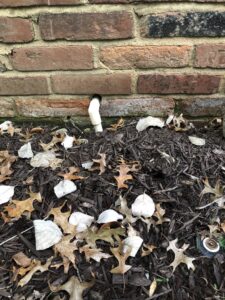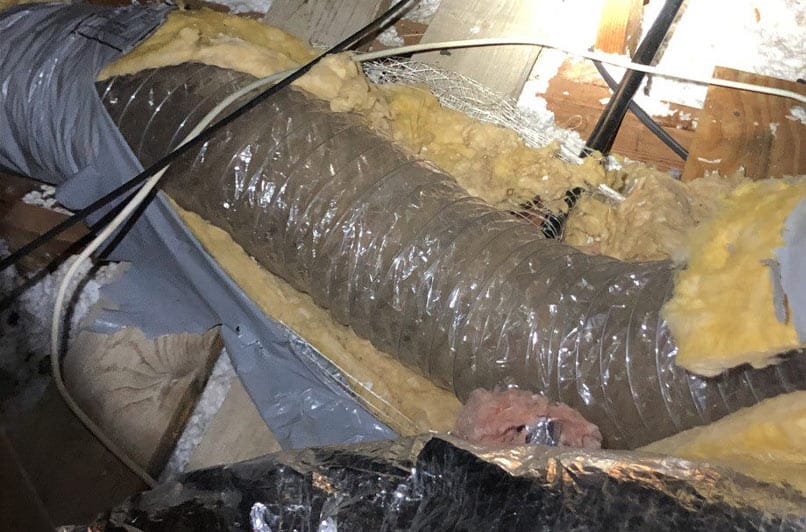Air ducts are an integral part of modern-day homes. These ducts, lying in a network throughout your home, are responsible for delivering air conditioning or heat through the air vents on your floors, walls, and ceilings.
It seems only reasonable to expect air to be the only thing coming out of those vents. So, if you spot a critter creeping through the ducts or hear telltale signs that indicate their presence, you’ll probably be caught off guard.
But if it’s a closed system, how do those impromptu guests sneak into the ducts uninvited? Here’s how they manage such a feat — and what you need to know about preventing them from sticking around or coming back.
How Do Animals Get Into Air Ducts?
Vermin and pests usually sneak into little openings or gaps in the vents of the ductwork. These little openings or gaps often go unnoticed by homeowners. Poorly sealed vents, damaged grates, or even gaps where pipes or wires enter your home are possible entry points small animals and pests need to sneak inside the HVAC ductwork.
The ducts themselves are bigger than you might think, so animals have little issue meandering through them. Most homes have ducts that are about 6–12 inches in diameter, although they might be a little bigger or smaller based on the specifics of your home.
Once inside, they’ll explore to their hearts’ content, often meandering along the channel in search of food, water, or the perfect nesting place. For most critters, that’s the appeal. They might catch a whiff of food or water, climbing in to find sustenance. Or, they might be looking for shelter and protection from predators, and since the ducts in your home offer both, they’ll happily take up residence there.

Common Pests & Animals You Might Find in Your HVAC System
Multiple critters might spot your home and view it as prime real estate. Each one may access your home differently. These critters include:
Rats
Rats are notorious for exploiting just about any gap or small opening in your home they can squeeze through, including those seemingly inconsequential gaps in your home’s air ducts. They’re incredibly agile, often squeezing through tiny gaps in foundations, roofs, or walls. Once they’re inside, they may make their way to your air ducts, where they can find warmth and shelter and travel undetected throughout your home.
Mice
Just like rats, mice are agile enough to wiggle through even the smallest holes and cracks. They’re experts in finding their way into air ducts, especially in attics, crawlspaces, or basements. Once they squeak inside, they may scurry through until they find what they’re searching for, whether that’s food, water, or the perfect place to build a nest.

Squirrels
Squirrels are another rodent that might take up residence in your home’s ducts. Like rats and mice, they’re incredibly nimble. Their impressive climbing skills allow them to make their way into your home through roof vents, soffits, or even chimney openings. Once inside, they may gnaw through duct material (and whatever else lies in their way) to enter your HVAC system and build a nest.
Opossums
As one of the larger critters on this list, you might be surprised to hear that opossums are another common pest in air ducts. Like the other pests, they’ll happily take up residence in your home if there’s a gap large enough to accommodate them.
These guys are opportunistic, often taking advantage of any holes or loose panels in your ductwork to gain entry. Unfortunately, once inside, their size works against them. They’re on the larger side, so they often make quite a bit of noise as they make their way through the ducts, which can quickly become annoying for you and problematic for the flow of air through your home.
Birds
Birds occasionally nest or get stuck in vents. Vents are attractive locations for birds to build nests off the ground, away from predators, and enclosed for protection from the elements. European starlings, house sparrows, and pigeons are some of the most common birds to nest in vents.
Bats
Bats are nocturnal critters, preferring the dark over the bright sunshine. This preference makes the dark, quiet places in your home (think your roof or attic) an appealing place to roost. Bats typically roost in the vents instead of inside the air ducts. The hot air vent attracts the bats, and they roost inside vents.
Unfortunately, these creatures can carry diseases, and their droppings can quickly accumulate, creating a health risk. Plus, once inside, they can be quite difficult to remove, given that they’re able to hide in tight, unreachable spaces.
Raccoons
Raccoons are remarkably resourceful. If they want inside your home, they’ll tear through all sorts of materials to get there. They have no qualms about ripping through roof vents, chimney caps, and attic fans to find the warmth and security they’re seeking.
Once inside, they may make their way into your air ducts for an added layer of warmth and protection. Much like opossums, they’re a bit large to get inside air ducts. They can cause extensive damage to the network of ductwork, creating tears and blockages throughout the system.
If left unchecked in your HVAC system, they can do quite a number on your home, wreaking havoc on your air conditioner.
Dangers of Animals in Your HVAC System
Having animals in your air ducts is more than an inconvenient nuisance — it can also be dangerous. Their presence can threaten your and your family’s health, not to mention the functionality of your HVAC system and other elements throughout your home. Having a pest problem in your HVAC is one of the few instances the EPA suggests air duct cleaning.
Health Risks Associated With Animal Infestations
The health risks stemming from animals in air ducts are one of the biggest concerns. Many of the creatures that take up residence in these areas carry harmful diseases.
For example, rodents like rats and mice can carry hantavirus, leptospirosis, and salmonella, which can be transmitted through their droppings and urine. Bat droppings can carry a fungus that causes histoplasmosis, a respiratory disease that can be severe in some cases.
Occasionally, an animal will die in your duct system. The dead animal smell will permeate through your home.
Since those ducts are responsible for pushing hot or cool air into your home, the presence of contaminants inside them is no good. The pathogens from animal feces and urine can circulate throughout your home when the HVAC system is running, contaminating the air you and your family breathe.
This may cause flare-ups of allergies, especially if you or a family member are allergic to animal dander. It may also cause unpleasant odors to spread throughout the entirety of your home, becoming more pungent when the HVAC system cycles.
Damage to HVAC Components

Beyond the health risks of animals in your air ducts, their presence can also damage the HVAC components. Many of these creatures tend to gnaw on things and have no qualms about chewing through whatever lies between them and their goal.
Rodents, for example, are notorious for chewing on things, including your air ducts, insulation, and even electrical wiring. This type of damage, which often requires pricey repairs, can throw a wrench into your HVAC system’s efficiency and functionality.
If your unwelcome guests decide to build a nest in your air ducts, you’ll encounter additional problems. The nesting materials from birds, squirrels, opossums, and raccoons can block airflow. This can dramatically reduce the efficiency of the HVAC system and force it to work harder than it should to cool or heat your home. The added strain can shorten your HVAC unit’s lifespan, potentially causing components like motors, fans, and compressors to break down.
Fire Hazards
As you’d probably guess, those same nesting materials that overwork your HVAC system are serious fire hazards. These nests are often made of dried leaves, twigs, and bits of fabric, among other things. They’re highly flammable, and if they build up inside your ducts near electrical components or heating elements, they can pose a major fire hazard.
On top of that, if the rodents gnaw through electrical wires on their way to their destination inside your ducts, they greatly increase the risk of electrical fires. This can put your entire home at risk.
Poor Indoor Air Quality
The health risks associated with animals in your air ducts go hand-in-hand with poor indoor air quality. As your HVAC system pushes air through the ductwork, it can move the urine, feces, and bacteria left by the animals.
When that air pushes through the vents into your home, it can lead to foul odors, respiratory irritation, and even the spread of disease. That poor air quality is a nightmare, especially for people with asthma, allergies, or other respiratory conditions. Unfortunately, the longer you or your family members are exposed to that foul air, the more exacerbated the issues and discomfort may become.
Identifying Signs of Animals in Your Air Ducts
Animals in HVAC ducts often give themselves away with a few telltale signs, including:
- Strange noises: Scratching, scurrying, or squeaking sounds from your air ducts are often one of the first signs of an infestation. These noises are often more noticeable at night when the house is quiet and the animals are more active.
- Foul odors: If you notice unpleasant odors coming from your vents, especially when your HVAC system kicks on, you might have animals in there. The odor can stem from their urine and feces and, in some cases, maybe the result of a dead animal in the air ducts.
- Visible signs: Tiny droppings or strewn nesting materials, especially around your vents, are a clear sign that animals have made their way into your ductwork.
- Airflow issues and reduced HVAC efficiency: If your electric bill is higher than it should be, your HVAC system is working harder than it normally does, or certain rooms in your home aren’t getting enough airflow, animals in the ducts could be to blame. Their nests can affect airflow, limiting your HVAC system’s efficiency.
How to Get Rid of Animals in Air Ducts
Getting rid of animals in your air ducts isn’t a DIY job and contains intricacies most HVAC technicians are not trained for. These areas are often hard to access, and the nuisance wildlife inside them can become aggressive when they feel threatened. Plus, removing them is usually only a temporary fix. Eventually, they’ll probably make their way back into the ducts.
So, how do you get rid of animals in air ducts? Call the professional wildlife and pest control service, Critter Control. Our local technicians have the experience and equipment necessary to safely and humanely remove uninvited pests.
After removing the nuisance wildlife, we’ll take a closer look at your home to determine how they got in and fix the problem to prevent future infestations. This might involve various exclusion tactics, such as sealing off entry points where they likely sneaked in the first time. We’ll apply disinfectant and deodorize the area after removal, ensuring we’ve removed all contaminants from the ductwork.
If you need help getting animals out of your air ducts, don’t hesitate to contact our team at Critter Control. Contact us today at 1-800-274-8837 or find an office near you.